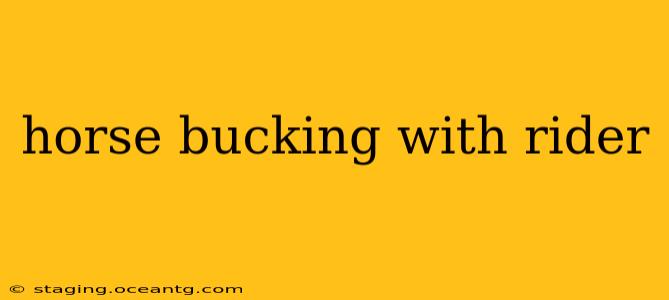Horse bucking is a forceful, unpredictable movement where the horse throws its hindquarters and shoulders upward, often accompanied by a dramatic arching of its back. For both experienced and novice riders, encountering a bucking horse can be a frightening and potentially dangerous experience. This comprehensive guide delves into the reasons behind this behavior, explores safety measures for riders, and offers insights into managing this challenging situation.
Why Do Horses Buck?
Understanding why a horse bucks is crucial for preventing it and reacting safely when it happens. Several factors can contribute to this behavior:
-
Youth and Inexperience: Young horses, especially those still developing their balance and coordination, often buck as a way to test their strength and explore their physical capabilities. This is often playful, but can still be dangerous for a rider.
-
Pain and Discomfort: A horse suffering from pain, whether from a saddle sore, an injury, or a digestive issue, may buck as a way to express discomfort. This is often accompanied by other signs of distress, like reluctance to move, unusual sweating, or changes in appetite.
-
Fear and Anxiety: Horses, like any animal, can experience fear and anxiety. Loud noises, unfamiliar objects, or stressful situations can trigger bucking as a defense mechanism.
-
Excitement and Energy: A horse with pent-up energy, particularly one that hasn't been adequately exercised, may buck as a release of excess enthusiasm. This is especially true in younger, more spirited horses.
-
Rider Error: Incorrect riding techniques, such as using harsh aids or an unbalanced seat, can inadvertently provoke bucking. Poor saddle fit can also cause discomfort leading to this behavior.
-
Breed Predisposition: Certain breeds, known for their spirited nature and athleticism, might have a higher predisposition to bucking, though this isn't a guarantee.
What Should You Do If Your Horse Starts Bucking?
Knowing how to react to a bucking horse is crucial for rider safety. Here are some essential steps to take:
-
Maintain a Secure Seat: Grip with your legs and maintain a centered, balanced position. Avoid leaning forward or backward. Focus on staying with the horse's movement rather than fighting it.
-
Relax Your Body: Tensing up can make you more likely to fall. Try to remain relaxed and flexible, allowing your body to move with the horse's motions.
-
Use Your Aids Effectively: While you shouldn't fight the bucking, subtle aids can help guide the horse to a calmer state. Avoid harsh or jarring movements.
-
Protect Your Head: Always wear a properly fitted riding helmet. Try to keep your head up and your chin tucked to avoid serious head injuries if you are thrown.
How Can I Prevent My Horse From Bucking?
Preventing bucking involves understanding your horse's individual needs and addressing potential triggers:
-
Consistent Training: Regular and consistent training builds a strong horse-rider bond and helps establish clear communication. This includes groundwork and desensitization exercises.
-
Regular Veterinary Care: Regular vet checks can identify and address any underlying medical issues that might be contributing to bucking.
-
Proper Saddle Fit: Ensure your saddle fits your horse correctly to avoid discomfort. This is crucial for preventing pain-induced bucking.
-
Appropriate Exercise: Regular, appropriate exercise helps burn off excess energy and prevents pent-up frustration.
-
Desensitization Training: Slowly introducing your horse to new sights, sounds, and situations can help reduce fear and anxiety.
Is Bucking Always a Sign of a Problem?
No, bucking isn't always a sign of a problem. Young horses, in particular, may buck as a normal part of their development. However, any sudden change in behavior or persistent bucking should warrant a veterinary examination to rule out any underlying issues.
Can Bucking Be Trained Out of a Horse?
While you can't completely eliminate the potential for bucking, especially in spirited breeds, consistent, positive training methods can significantly reduce its frequency and severity. Professional training from an experienced horse handler is often beneficial.
What is the Difference Between Bucking and Rearing?
Bucking involves forceful movements of the hindquarters and shoulders, often accompanied by an arched back. Rearing, on the other hand, involves the horse rising up on its hind legs, potentially more dangerous as it can lead to falling backward. Both actions require skilled handling and caution.
By understanding the causes of bucking and employing appropriate preventative and reactive measures, riders can significantly improve their safety and maintain a positive and harmonious relationship with their horses. Remember, patience, consistency, and professional guidance are key to addressing this challenging equine behavior.
